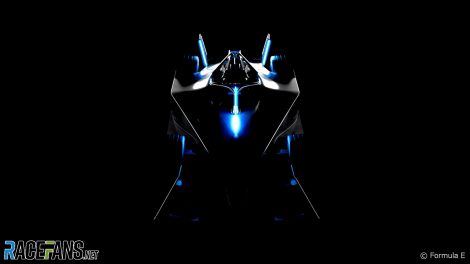Formula E has presented the first images of its third generation car which will be introduced for the ninth running of the all-electric championship in 2023.
The series presented its ‘Gen3’ machine to manufacturers, teams, drivers and others at Valencia today, where testing for the final season with the current ‘Gen2’ machine is underway. Formula E says its new model will be lighter than the current design, which tips the scales at 903 kilograms including driver, but has not indicated the scale of the reduction.The external dimensions of the new machine have also been reduced compared to the one it replaces, which measures 5.16m long, 1.77m wide and 1.05m tall.
A major change at the front of the car will see the addition of a second powertrain. According to Formula E the new car will have more than double the energy regenerating capability of its predecessor, and its 350kW (470bhp) motor will push the car to a top speed over more than 320kph (200mph).

Formula E says the scaled down yet more powerful car will be better suited to racing on the compact city street courses the series favours.
The championship has taken further steps to ensure the cars and parts associated with them will be produced and disposed of in a sustainable manner. The car will be a net-zero contributor to carbon emissions and all suppliers must achieve the FIA’s three-star environmental accreditation certificate before the 2023 season begins.
Formula E also plans to recycle damaged carbon fibre parts from its cars. Its tyres will be made from 26% sustainable materials.

“Together with the FIA, we have built the world’s most efficient and sustainable high performance race car.
“The Gen3 is our fastest, lightest, most powerful and efficient racing car yet. It is a creature designed for its habitat: racing on city streets in wheel-to-wheel combat. We look forward to witnessing it inspire and excite the next generation of motorsport fans in cities around the world from season nine of the ABB FIA Formula E world championship.”
Advert | Become a RaceFans supporter and
Formula E
- Jaguar’s team work gives Evans and Cassidy Monaco one-two
- Formula E unveils 200mph, 4WD Gen3 Evo, boasting 0-60 time 30% quicker than F1
- Wehrlein wins second Misano race after Rowland’s last lap heartache
- Da Costa disqualified from first Misano race, handing Rowland win
- Da Costa becomes sixth different winner in six rounds in first Misano race
Browse all Formula E articles





JustSomeone
29th November 2021, 19:24
Interesting, creeping closer:
2021 F1 752kg
2022 F1 790kg
202x FE 903kg
2023 FE <900kg
For reference: 1995-2008 F1 595kg
Source: 1st google hit
thegamer23
29th November 2021, 19:45
GEN 3 minimum weight is set to be around 780 KG
A massive reduction compared to the current one, and much more power available.
It’s going to be a big step forward.
minnis (@minnis)
29th November 2021, 20:35
Do you have a source? As the article above literally states that they haven’t disclosed the weight.
anon
30th November 2021, 22:29
@minnis the tender documents that were issued for the Gen 3 car stated the objective was to cut the weight of the car by 120kg. The plan is to reduce the weight of the cells within the battery from 284kg to 180kg and the weight of the exterior casing and the cooling system being reduced by a further 16kg, taking the overall battery weight down from 385kg to 265kg. https://motorsport.tech/formula-e/gen3-formula-es-big-step-into-unchartered-territory
That is where the figure of 780kg comes from – people have taken the current circa 900kg weight of the cars and taken that objective of cutting 120kg from the weight from the current car weight. Whether that can actually be achieved is another matter though – the current Gen 2 car was originally meant to have been lighter than the Gen 1 car, but there were reports during the development phase that McLaren fell a long way short of the objectives for the weight and size of the battery pack, hence why that car ended up being heavier than the Gen 1 car.
Steve
29th November 2021, 19:49
The target for Gen 3 is 780kg. Also, don’t forget to include fuel. Half a tank of fuel weighs 55kg, so to update your numbers:
2021 F1 807kg
2022 F1 845kg
202x FE 903kg
2023 FE target: 780kg
TC
29th November 2021, 23:01
2022 F1 = 900kg full tank
2023 F3 = 780kg
JustSomeone
29th November 2021, 19:28
2021 F2 755kg
2021 IndyCar ~740kg
(Note: forgot to check if any include the driver though)
Steven
29th November 2021, 20:05
F2 includes the driver but not fuel, which averages 45kg, totalling an average of 800kg.
Indycar doesn’t include either the driver or fuel. Fuel averages 25kg (they refuel during the race) but I’m not sure what they allocate for the driver.
someone or something
29th November 2021, 22:29
F1 weight limit includes driver, or rather: the 80 kilo driver cell including the driver (in order to minimise disadvantages for heavier drivers).
Pretty sure IndyCar does too, but don’t quote me on that.
Stash (@stash)
30th November 2021, 20:27
No way! Are you suggesting that Webber weighing 8kg heavier than Vettel was a factor? I thought everyone said it had no bearing at all. It appears after all of this time that it was a huge handicap. Better late than never. Not bad for a number two driver who weighed significantly more than Vettel. Significantly. No wonder Webber could hold his own on tracks like Monaco and not other tracks. Ah; if only he had of had a fair shot at it. I could not miss that opportunity. Hi Keith – how you doin’?
MacLeod (@macleod)
1st December 2021, 8:24
@stash Driver weight was an issue that is why F1 included a driver weight of 75kg for everyone but it’s new. Nico Hulkenberg was one of those drivers heavy dissavantaged.
In the time of Vettel and Weber Weber was slower just be being heavier (that was why Weber looked if he hadn’t eat for 3 months)
anon
30th November 2021, 17:52
JustSomeone, firstly, the minimum weight of an IndyCar depends on whether you are comparing the road course (i.e. anything other than an oval), short oval or speedway package, because they are all different. IndyCar’s regulations specify the following minimum weights:
Speedway: 1655lb (751kg)
Short Oval: 1690lb (767kg)
Road Course: 1700lb (771kg)
Secondly, the minimum weight excludes the driver and driver ballast, which adds another 185lb (84kg) to the figures above. An IndyCar in road course trim and with the driver onboard would therefore have a minimum weight of 855kg.
Steven
29th November 2021, 20:35
Don’t forget the fuel. The fuel on an F1 car weighs 110kg, but if we average it over a race it’s 55kg.
Also, the Gen 3 FE car should be 780kg.
F1 2021: 752 + 55 fuel = 807kg
F1 2022: 790 + 55 fuel = 845kg
FE 2022: 903kg
FE 2023: ~780kg
F2 2021: 755 + 45 fuel = 800kg
Indycar 2021: 750 + 26 fuel + 84 driver = 860kg
Indycar 2022: 804 + 26 fuel + 84 driver = 914kg
(84kg is for the driver.)
2023’s FE car will be by far the lightest of the open wheel racing cars. Now they just need active aero :)
ADUB SMALLBLOCK (@waptraveler)
29th November 2021, 20:50
Any info on if there was any change to power store capacity/range?
tomer
29th November 2021, 21:57
The battery will get smaller, to compensate for this the Regen gets a bigger increase 600kw compared to energy consumption max 350kw
Tristan (@skipgamer)
29th November 2021, 23:17
What are those pictures? Can’t even see the design. Ridiculous.
SteveR
30th November 2021, 3:03
It’s some sort of Star Wars thingie I guess…..
Phil Norman (@phil-f1-21)
30th November 2021, 4:41
I agree. You cannot actually see anything clearly. Pictures are too dark to make out the basic shape even.
A person somewhere
30th November 2021, 6:52
Using stronger lighting in the studio would not have been sustainable ;)
thegamer23
30th November 2021, 9:03
It’s a teaser, not the official reveal
Learon
30th November 2021, 13:13
Looks like the Christmas lights in my front room.
NS Biker (@rekibsn)
30th November 2021, 5:14
If the cars and racing is supposed to be “sustainable” why build a spec car, chassis and bodywork, out of carbon fiber.?
In competitive technical series, yes, there is an advantage, but with a level playing field with a spec car, using carbon fiber makes no sense apart from the “Bling Factor”.
Yes it is lighter and stiffer than other materials, but does it improve the racing or just contribute to the debris on-track from the inevitable collisions.?
Not to worry, F1 is already looking at natural fibers (read as hemp) for some components.
Palaboran
30th November 2021, 10:59
The hemp will still be a composite therefor sharp shards are inevitable.
Rhys Lloyd (@justrhysism)
2nd December 2021, 4:07
@rekibsn uhh lighter vehicles tend to provide better racing as the cars are more nimble. So yeah, carbon is much more than “bling factor”.
theRealMax (@millionus)
30th November 2021, 8:54
5m long..! Does it have a boot (trunk to those across the pond) as well?
Chris Horton
30th November 2021, 11:08
I can’t see it.
Zafka (@jjlehto)
30th November 2021, 11:57
Formula mEh
jet
1st December 2021, 13:17
F1 is relevant enough that they don’t have to go electric. But the longer they wait, the less relevant they will be. This is a good year for F1. Every bad year they have from here on will point more people to FE. F1 could make a much more race worthy car than FE is putting out. It’s only a matter of time till they do.